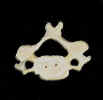

 Superior view
Superior viewThe superior most seven vertebrae are the cervical vertebrae. They are unique in several ways. Most have a bifid spinous process, although the seventh cervical vertebra has a single spinous process. The bodies are wider from side to side than from anterior to posterior. In the adult the body will be smaller than that of the other areas as they carry less weight. The vertebral foramen is triangular and large. This is important because the spinal cord is largest at its superior end. They have a transverse foramen (foramen transversarium) that houses the vertebral artery and vein in the first six vertebrae and only the vertebral vein in the seventh. The vertebral artery is of particular importance because it serves the brain and spinal cord. The vertebral vein does not serve much of the brain, but rather receives blood from the cervical spinal cord, cervical vertebrae, and some of the small muscles in the superior portion of the neck. The articulations of the cervical vertebrae are in a oblique plane. This is important functionally because it increases the range of motion that we have in the cervical region including rotation, lateral flexion, flexion, and extension.
COPYRIGHT
2007 by William C. Johnson II
ALL RIGHTS RESERVED!